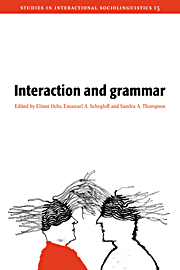Book contents
- Frontmatter
- Contents
- Notes on the contributors
- 1 Introduction
- 2 Turn organization: one intersection of grammar and interaction
- 3 Interactional units in conversation: syntactic, intonational, and pragmatic resources for the management of turns
- 4 Resources and repair: a cross-linguistic study of syntax and repair
- 5 On the “semi-permeable” character of grammatical units in conversation: conditional entry into the turn space of another speaker
- 6 On repeats and responses in Finnish conversations
- 7 “When I come down I'm in the domain state”: grammar and graphic representation in the interpretive activity of physicists
- 8 Transparent vision
- 9 Conversational signifying: grammar and indirectness among African American women
- 10 Creating evidence: making sense of written words in Bosavi
- Appendix Transcription conventions
- Index
3 - Interactional units in conversation: syntactic, intonational, and pragmatic resources for the management of turns
Published online by Cambridge University Press: 14 January 2010
- Frontmatter
- Contents
- Notes on the contributors
- 1 Introduction
- 2 Turn organization: one intersection of grammar and interaction
- 3 Interactional units in conversation: syntactic, intonational, and pragmatic resources for the management of turns
- 4 Resources and repair: a cross-linguistic study of syntax and repair
- 5 On the “semi-permeable” character of grammatical units in conversation: conditional entry into the turn space of another speaker
- 6 On repeats and responses in Finnish conversations
- 7 “When I come down I'm in the domain state”: grammar and graphic representation in the interpretive activity of physicists
- 8 Transparent vision
- 9 Conversational signifying: grammar and indirectness among African American women
- 10 Creating evidence: making sense of written words in Bosavi
- Appendix Transcription conventions
- Index
Summary
Introduction
The research reported in this chapter is intended as a contribution to an understanding of the basic linguistic units used by speakers in spontaneous communication. Our interest is in the linguistic factors associated with the split-second timing of next turn onset that has been documented in conversation analytic literature (Sacks, Schegloff, and Jefferson, 1974; Jefferson, 1973; Wilson and Zimmerman, 1986).
In the past two decades, conversation analysts have uncovered patterns and principles of interaction, particularly in the areas of turn-taking and the sequential organization of talk. The picture of spontaneous interaction that emerges very clearly from this research depicts a complex and intricately monitored human practice that is maximally sensitive to moment-by-moment input by all parties to a conversation, and is, therefore, characterized by an organization that is locally managed. Turns at talk vary widely in length, and their length is not unilaterally controlled. The extension of a turn at talk has everything to do with the manner in which that turn is being responded to by the other participant(s) in the conversation (e.g., Atkinson and Heritage, 1984; Davidson, 1984; C. Goodwin, 1979, 1981, 1986a, 1986b, 1987; M. Goodwin, 1980; Goodwin and Goodwin, 1986, 1987, forthcoming; Heritage, 1984, 1989; Jefferson, 1973, 1987, 1989; Lerner, 1987, 1989, 1991, in progress; Sacks, et al. 1974; Schegloff, 1979, 1980, 1982, 1986, 1987, 1988, 1989, 1990, 1992; Schegloff and Sacks, 1973; Wilson and Zimmerman, 1986; and Wilson et al. 1984). To understand the syntax and rhetoric of conversational language use, linguists need to take very seriously the situated practices of conversationalists as revealed in the careful work of conversation analysts.
- Type
- Chapter
- Information
- Interaction and Grammar , pp. 134 - 184Publisher: Cambridge University PressPrint publication year: 1996
- 313
- Cited by



